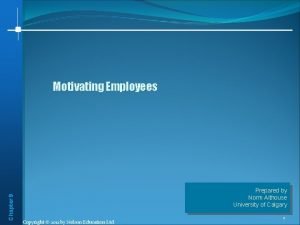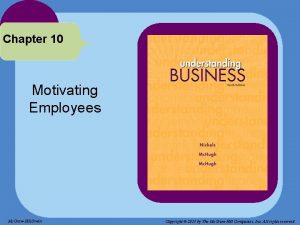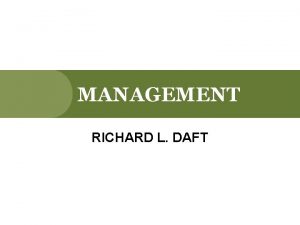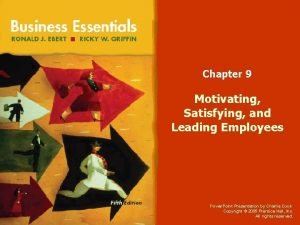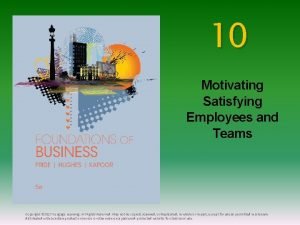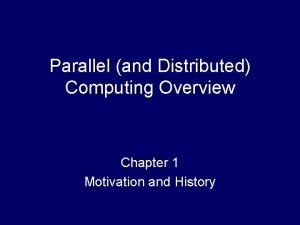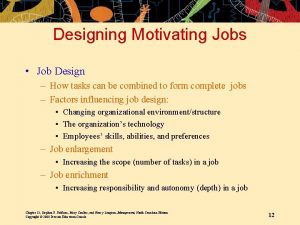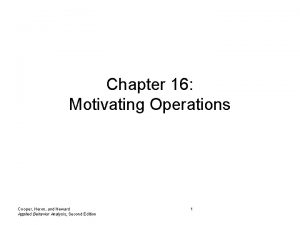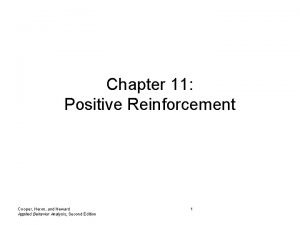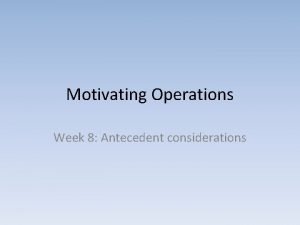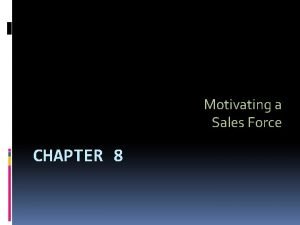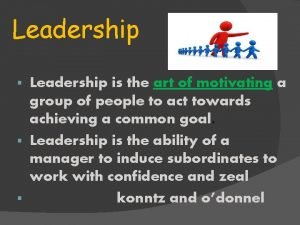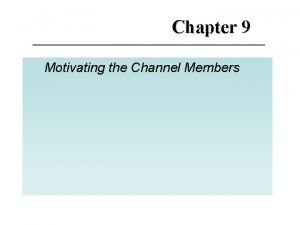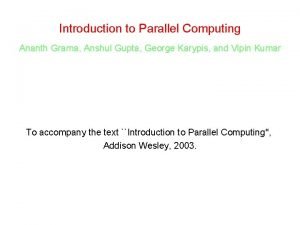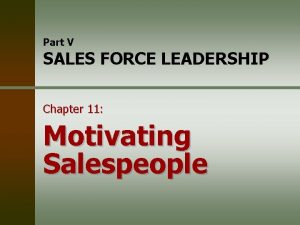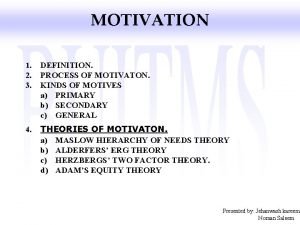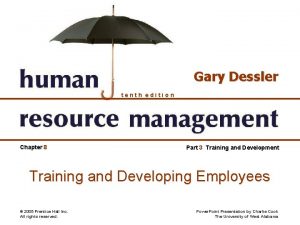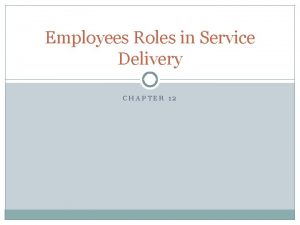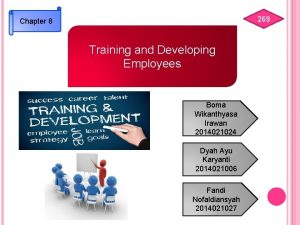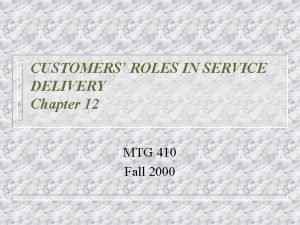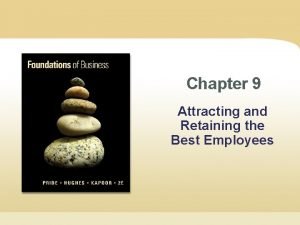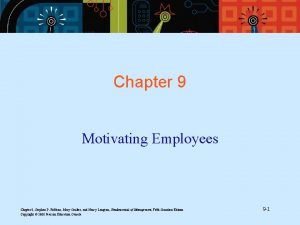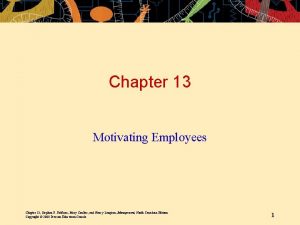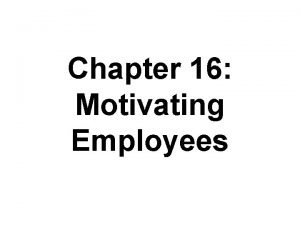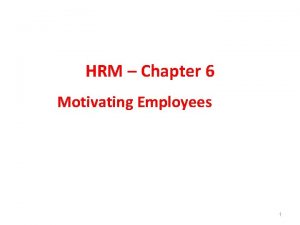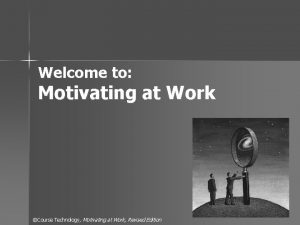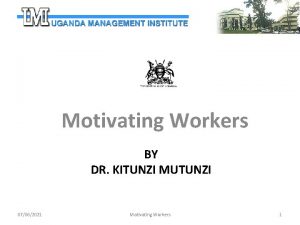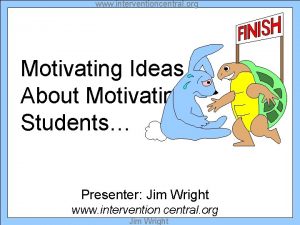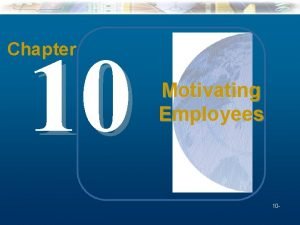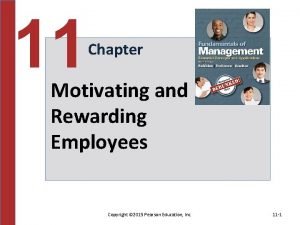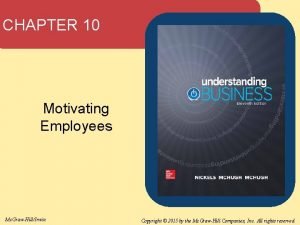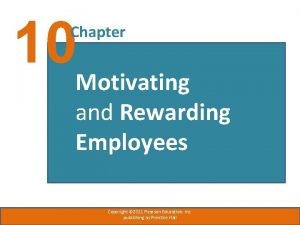Chapter 13 Motivating Employees Chapter 13 Stephen P





































- Slides: 37

Chapter 13 Motivating Employees Chapter 13, Stephen P. Robbins, Mary Coulter, and Nancy Langton, Management, Eighth Canadian Edition. Copyright © 2005 Pearson Education Canada Inc. 1

LEARNING OUTLINE Follow this Learning Outline as you read and study this chapter. • What Is Motivation? – Define motivation. – Explain motivation as a need-satisfying process. Chapter 13, Stephen P. Robbins, Mary Coulter, and Nancy Langton, Management, Eighth Canadian Edition. Copyright © 2005 Pearson Education Canada Inc. 2

LEARNING OUTLINE Follow this Learning Outline as you read and study this chapter. • Early Theories of Motivation – Describe the five levels in Maslow’s hierarchy and how Maslow’s hierarchy can be used in motivational efforts. – Discuss how Theory X and Theory Y managers approach motivation. – Describe Herzberg’s motivation-hygiene theory. – Explain Herzberg’s views of satisfaction and dissatisfaction. Chapter 13, Stephen P. Robbins, Mary Coulter, and Nancy Langton, Management, Eighth Canadian Edition. Copyright © 2005 Pearson Education Canada Inc. 3

LEARNING OUTLINE (cont’d) Follow this Learning Outline as you read and study this chapter. • Contemporary Theories of Motivation – Describe the job characteristics model as a way to design motivating jobs. – Discuss the motivation implications of equity theory. – Contrast distributive justice and procedural justice. – Explain the three key variables in expectancy theory and their role in motivation. Chapter 13, Stephen P. Robbins, Mary Coulter, and Nancy Langton, Management, Eighth Canadian Edition. Copyright © 2005 Pearson Education Canada Inc. 4

LEARNING OUTLINE (cont’d) Follow this Learning Outline as you read and study this chapter. • Current Issues in Motivation – Describe the cross-cultural challenges of motivation. – Discuss the challenges managers face in motivating unique groups of employees. – Describe open-book management and employee recognition, pay-for-performance, and stock option programs. • From Theory To Practice: Suggestions For Motivating Employees Chapter 13, Stephen P. Robbins, Mary Coulter, and Nancy Langton, Management, Eighth Canadian Edition. Copyright © 2005 Pearson Education Canada Inc. 5

What Is Motivation? • Motivation – The processes that account for an individual’s willingness to exert high levels of effort to reach organizational goals, conditioned by the effort’s ability to satisfy some individual need • Effort: a measure of intensity or drive • Direction: toward organizational goals • Need: personalized reason to exert effort – Motivation works best when individual needs are compatible with organizational goals Chapter 13, Stephen P. Robbins, Mary Coulter, and Nancy Langton, Management, Eighth Canadian Edition. Copyright © 2005 Pearson Education Canada Inc. 6

Exhibit 13. 1 The Motivation Process Unsatisfied Need Tension Effort Satisfied Need Tension Reduction • Intensity • Direction • Persistence Chapter 13, Stephen P. Robbins, Mary Coulter, and Nancy Langton, Management, Eighth Canadian Edition. Copyright © 2005 Pearson Education Canada Inc. 7

Early Theories of Motivation • Maslow’s Hierarchy of Needs Theory – Needs were categorized as five levels • Individuals must satisfy lower-order needs before they can satisfy higher order needs • Satisfied needs will no longer motivate • Motivating a person depends on knowing at what level that person is on the hierarchy – Hierarchy of needs • Lower-order (external): physiological, safety • Higher-order (internal): social, esteem, selfactualization Chapter 13, Stephen P. Robbins, Mary Coulter, and Nancy Langton, Management, Eighth Canadian Edition. Copyright © 2005 Pearson Education Canada Inc. 8

Exhibit 13. 2 Maslow’s Hierarchy of Needs Self. Actualization Esteem Social Safety Physiological Chapter 13, Stephen P. Robbins, Mary Coulter, and Nancy Langton, Management, Eighth Canadian Edition. Copyright © 2005 Pearson Education Canada Inc. 9

Early Theories of Motivation (cont’d) • Mc. Gregor’s Theory X and Theory Y – Theory X • Employees have little ambition, dislike work, avoid responsibility, and require close supervision – Theory Y • Employees can exercise self-direction, desire responsibility, and like to work – Motivation is maximized by participative decision making, interesting jobs, and good group relations Chapter 13, Stephen P. Robbins, Mary Coulter, and Nancy Langton, Management, Eighth Canadian Edition. Copyright © 2005 Pearson Education Canada Inc. 10

Early Theories of Motivation (cont’d) • Herzberg’s Motivation-hygiene Theory – Job satisfaction and job dissatisfaction are created by different factors • Hygiene factors: extrinsic (environmental) factors that create job dissatisfaction • Motivators: intrinsic (psychological) factors that create job satisfaction – Attempted to explain why job satisfaction does not result in increased performance • The opposite of satisfaction is not dissatisfaction, but rather no satisfaction Chapter 13, Stephen P. Robbins, Mary Coulter, and Nancy Langton, Management, Eighth Canadian Edition. Copyright © 2005 Pearson Education Canada Inc. 11

Exhibit 13. 3 Herzberg’s Motivation-Hygiene Theory Motivators • • • Hygiene Factors Achievement Recognition Work Itself Responsibility Advancement Growth Extremely Satisfied • Supervision • Company Policy • Relationship with Supervisor • Working Conditions • Salary • Relationship with Peers • Personal Life • Relationship with Subordinates • Status • Security Neutral Chapter 13, Stephen P. Robbins, Mary Coulter, and Nancy Langton, Management, Eighth Canadian Edition. Copyright © 2005 Pearson Education Canada Inc. Extremely Dissatisfied 12

Exhibit 13. 4 Contrasting Views of Satisfaction–Dissatisfaction Traditional View Satisfied Dissatisfied Herzberg’s View Motivators Satisfaction No Satisfaction Hygiene Factors No Dissatisfaction Chapter 13, Stephen P. Robbins, Mary Coulter, and Nancy Langton, Management, Eighth Canadian Edition. Copyright © 2005 Pearson Education Canada Inc. Dissatisfaction 13

Designing Motivating Jobs • Job Design – How tasks can be combined to form complete jobs – Factors influencing job design: • Changing organizational environment/structure • The organization’s technology • Employees’ skills, abilities, and preferences – Job enlargement • Increasing the scope (number of tasks) in a job – Job enrichment • Increasing responsibility and autonomy (depth) in a job Chapter 13, Stephen P. Robbins, Mary Coulter, and Nancy Langton, Management, Eighth Canadian Edition. Copyright © 2005 Pearson Education Canada Inc. 14

Designing Motivating Jobs (cont’d) • Job Characteristics Model (JCM) – A framework for designing motivating jobs – Five primary job characteristics: • Skill variety: how many skills and talents are needed? • Task identity: does the job produce a complete work? • Task significance: how important is the job? • Autonomy: how much independence does the jobholder have? • Feedback: do workers know how well they are doing? Chapter 13, Stephen P. Robbins, Mary Coulter, and Nancy Langton, Management, Eighth Canadian Edition. Copyright © 2005 Pearson Education Canada Inc. 15

Exhibit 13. 5 Job Characteristics Model Core Job Dimensions Skill Variety Task Identity Task Significance Critical Psychological States Experienced meaningfulness of the work Autonomy Experienced responsibility for outcomes of the work Feedback Knowledge of the actual results of the work activities Personal and Work Outcomes High Internal Work Motivation High-Quality Work Performance High Satisfaction with the Work Low Absenteeism and Turnover Source: J. R. Hackman and J. L. Suttle (eds. ). Improving Life at Work (Glenview, IL: Scott, Foresman, 1977). With permission of the authors. Chapter 13, Stephen P. Robbins, Mary Coulter, and Nancy Langton, Management, Eighth Canadian Edition. Copyright © 2005 Pearson Education Canada Inc. 16

Exhibit 13. 6 Guidelines for Job Redesign Source: J. R. Hackman and J. L. Suttle (eds. ). Improving Life at Work (Glenview, IL: Scott, Foresman, 1977). With permission of the authors. Chapter 13, Stephen P. Robbins, Mary Coulter, and Nancy Langton, Management, Eighth Canadian Edition. Copyright © 2005 Pearson Education Canada Inc. 17

Motivation and Perception • Equity Theory – Proposes that employees perceive what they get from a job situation (outcomes) in relation to what they put in (inputs) and then compare their inputs-outcomes ratio with the inputs-outcomes ratios of relevant others • If the ratios are perceived as equal then a state of equity (fairness) exists • If the ratios are perceived as unequal, inequity exists and the person feels under- or over-rewarded • When inequities occur, employees will attempt to do something to rebalance the ratios (seek justice) Chapter 13, Stephen P. Robbins, Mary Coulter, and Nancy Langton, Management, Eighth Canadian Edition. Copyright © 2005 Pearson Education Canada Inc. 18

Motivation and Perception (cont’d) • Equity Theory (cont’d) – Employee responses to perceived inequities: • Distort own or others’ ratios • Induce others to change their own inputs or outcomes • Change own inputs (increase or decrease efforts) or outcomes (seek greater rewards) • Choose a different comparison (referent) other (person, systems, or self) • Quit their job – Employees are concerned with both the absolute and relative nature of organizational rewards Chapter 13, Stephen P. Robbins, Mary Coulter, and Nancy Langton, Management, Eighth Canadian Edition. Copyright © 2005 Pearson Education Canada Inc. 19

Exhibit 13. 7 Equity Theory Ratio of Output to Input Person 1’ s Perception Person 1 Person 2 Inequity, under-rewarded Person 1 Equity Person 2 Person 1 Inequity, over-rewarded Person 2 Chapter 13, Stephen P. Robbins, Mary Coulter, and Nancy Langton, Management, Eighth Canadian Edition. Copyright © 2005 Pearson Education Canada Inc. 20

Motivation and Perception (cont’d) • Equity Theory (cont’d) – Distributive Justice • The perceived fairness of the amount and allocation of rewards among individuals (i. e. , who received what) – Influences an employee’s satisfaction – Procedural Justice • The perceived fairness of the process used to determine the distribution of rewards (i. e. , how who received what) – Affects an employee’s organizational commitment Chapter 13, Stephen P. Robbins, Mary Coulter, and Nancy Langton, Management, Eighth Canadian Edition. Copyright © 2005 Pearson Education Canada Inc. 21

Motivation, Perception, and Behaviour • Expectancy Theory – Individuals act based on the expectation that a given outcome will follow and whether that outcome is attractive – Key to theory is understanding and managing employee goals and the linkages among and between effort, performance, and rewards • Effort: employee abilities and training/development • Performance: valid appraisal systems • Rewards (goals): understanding employee needs Chapter 13, Stephen P. Robbins, Mary Coulter, and Nancy Langton, Management, Eighth Canadian Edition. Copyright © 2005 Pearson Education Canada Inc. 22

Exhibit 13. 8 Simplified Expectancy Model Individual Effort A Individual Performance B Organizational Rewards C Individual Goals A = Effort-performance linkage B = Performance-reward linkage C = Attractiveness of reward Chapter 13, Stephen P. Robbins, Mary Coulter, and Nancy Langton, Management, Eighth Canadian Edition. Copyright © 2005 Pearson Education Canada Inc. 23

Motivation, Perception, and Behaviour (cont’d) • Expectancy Relationships – Expectancy (effort-performance linkage) • The perceived probability that an individual’s effort will result in a certain level of performance – Instrumentality • The perception that a particular level of performance will result in attaining a desired outcome (reward) – Valence • The attractiveness/importance of the performance reward (outcome) to the individual Chapter 13, Stephen P. Robbins, Mary Coulter, and Nancy Langton, Management, Eighth Canadian Edition. Copyright © 2005 Pearson Education Canada Inc. 24

Exhibit 13. 9 Increasing Motivation Improving Expectancy Improve the ability of the individual to perform • Make sure employees have skills for the task. • Provide training. • Assign reasonable tasks and goals. Improving Instrumentality Increase the individual’s belief that performance will lead to reward • Observe and recognize performance. • Deliver rewards as promised. • Indicate to employees how previous good performance led to greater rewards. Chapter 13, Stephen P. Robbins, Mary Coulter, and Nancy Langton, Management, Eighth Canadian Edition. Copyright © 2005 Pearson Education Canada Inc. Improving Valence Make sure that the reward is meaningful to the individual • Ask employees what rewards they value. • Give rewards that are valued. 25

Current Issues in Motivation • Cross-cultural Challenges – Motivational programs are most applicable in cultures where individualism and quality of life are cultural characteristics • Uncertainty avoidance of some cultures inverts Maslow’s needs hierarchy • The need for achievement (n. Ach) is lacking in other cultures • Collectivist cultures view rewards as “entitlements” to be distributed based on individual needs, not individual performance Chapter 13, Stephen P. Robbins, Mary Coulter, and Nancy Langton, Management, Eighth Canadian Edition. Copyright © 2005 Pearson Education Canada Inc. 26

Current Issues in Motivation (cont’d) • Cross-cultural Consistencies – Interesting work is widely desired, as is growth, achievement, and responsibility Chapter 13, Stephen P. Robbins, Mary Coulter, and Nancy Langton, Management, Eighth Canadian Edition. Copyright © 2005 Pearson Education Canada Inc. 27

Current Issues in Motivation (cont’d) • Motivating Unique Groups of Workers – Motivating a diverse workforce through flexibility: • Men desire more autonomy than do women • Women desire learning opportunities, flexible work schedules, and good interpersonal relations Chapter 13, Stephen P. Robbins, Mary Coulter, and Nancy Langton, Management, Eighth Canadian Edition. Copyright © 2005 Pearson Education Canada Inc. 28

Exhibit 13. 10 Snapshots of Cultural Differences in Motivation Chapter 13, Stephen P. Robbins, Mary Coulter, and Nancy Langton, Management, Eighth Canadian Edition. Copyright © 2005 Pearson Education Canada Inc. 29

Current Issues in Motivation (cont’d) • Flexible Work/Job Schedules – Compressed workweek • Longer daily hours, but fewer days – Flexible work hours (flextime) • Specific weekly hours with varying arrival, departure, lunch and break times around certain core hours during which all employees must be present – Job Sharing • Two or more people split a full-time job – Telecommuting • Employees work from home using computer links Chapter 13, Stephen P. Robbins, Mary Coulter, and Nancy Langton, Management, Eighth Canadian Edition. Copyright © 2005 Pearson Education Canada Inc. 30

Current Issues in Motivation (cont’d) • Motivating Professionals – Characteristics of professionals • Strong and long-term commitment to their field of expertise • Loyalty is to their profession, not to the employer • Have the need to regularly update their knowledge • Don’t define their workweek as 8: 00 am to 5: 00 pm – Motivators for professionals • Job challenge • Organizational support of their work Chapter 13, Stephen P. Robbins, Mary Coulter, and Nancy Langton, Management, Eighth Canadian Edition. Copyright © 2005 Pearson Education Canada Inc. 31

Current Issues in Motivation (cont’d) • Motivating in a Unionized Environment – Unionized workplaces provide challenges to motivation theories – Canadian unions not very receptive to pay-forperformance plans – Unions worry that differential pay for doing similar work can hurt cooperation Chapter 13, Stephen P. Robbins, Mary Coulter, and Nancy Langton, Management, Eighth Canadian Edition. Copyright © 2005 Pearson Education Canada Inc. 32

Current Issues in Motivation (cont’d) • Motivating in the Public Sector – Productivity is more difficult to measure because the work carried out is often of a service nature – Harder to make link between rewards and productivity – Research suggests that setting goals significantly improves motivation of public sector employees Chapter 13, Stephen P. Robbins, Mary Coulter, and Nancy Langton, Management, Eighth Canadian Edition. Copyright © 2005 Pearson Education Canada Inc. 33

Current Issues in Motivation (cont’d) • Motivating Contingent Workers – Opportunity to become a permanent employee – Opportunity for training – Equity in compensation and benefits • Motivating Low-Skilled, Minimum-Wage Employees – Employee recognition programs – Provision of sincere praise Chapter 13, Stephen P. Robbins, Mary Coulter, and Nancy Langton, Management, Eighth Canadian Edition. Copyright © 2005 Pearson Education Canada Inc. 34

Current Issues in Motivation (cont’d) • Designing Appropriate Rewards Programs – Open-book management • Involving employees in workplace decision by opening up the financial statements of the employer – Employee recognition programs • Giving personal attention and expressing interest, approval, and appreciation for a job well done – Pay-for-performance • Variable compensation plans that reward employees on the basis of their performance: – Piece rates, wage incentives, profit-sharing, and lump-sum bonuses Chapter 13, Stephen P. Robbins, Mary Coulter, and Nancy Langton, Management, Eighth Canadian Edition. Copyright © 2005 Pearson Education Canada Inc. 35

Current Issues in Motivation (cont’d) • Designing Appropriate Rewards Programs (cont’d) – Stock option programs • Using financial instruments (in lieu of monetary compensation) that give employees the right to purchase shares of company stock at a set (option) price • Options have value if the stock price rises above the option price; they become worthless if the stock price falls below the option price Chapter 13, Stephen P. Robbins, Mary Coulter, and Nancy Langton, Management, Eighth Canadian Edition. Copyright © 2005 Pearson Education Canada Inc. 36

Ex. 13. 11 From Theory to Practice Recognize individual differences Match people to jobs Don’t ignore money Use recognition Guidelines for Motivating Employees Check the system for equity Chapter 13, Stephen P. Robbins, Mary Coulter, and Nancy Langton, Management, Eighth Canadian Edition. Copyright © 2005 Pearson Education Canada Inc. Individualize rewards Link rewards to performance 37
 Motivating and satisfying employees and teams
Motivating and satisfying employees and teams Is the individual internal process that energizes directs
Is the individual internal process that energizes directs Norm althouse
Norm althouse Chapter 10 motivating employees
Chapter 10 motivating employees Chapter 10 motivating employees
Chapter 10 motivating employees Ways of motivating employees
Ways of motivating employees Motivating employees without money
Motivating employees without money Motivating and satisfying employees and teams
Motivating and satisfying employees and teams Motivating and satisfying employees and teams
Motivating and satisfying employees and teams Motivating and satisfying employees and teams
Motivating and satisfying employees and teams Motivating parallelism
Motivating parallelism How to motivate esl students
How to motivate esl students Designing motivating jobs
Designing motivating jobs Conditioned motivating operations
Conditioned motivating operations Three-term contingency example
Three-term contingency example Motivating operations definition
Motivating operations definition Motivating sales force
Motivating sales force Exploitative authoritative example
Exploitative authoritative example Channel motivation
Channel motivation Planning organizing staffing directing controlling
Planning organizing staffing directing controlling Motivation for software developers
Motivation for software developers Introduction to parallel computing grama
Introduction to parallel computing grama Motivating forces for exploration
Motivating forces for exploration Motivating people for total quality
Motivating people for total quality Motivating sales force
Motivating sales force Motivating yourself and others
Motivating yourself and others Reflexive conditioned motivating operation
Reflexive conditioned motivating operation I am feeling positive
I am feeling positive Motivating parallelism
Motivating parallelism Want satisfaction chain
Want satisfaction chain Leading and motivating a team
Leading and motivating a team Process of controling
Process of controling Motivating example
Motivating example Chapter 8 training and developing employees
Chapter 8 training and developing employees Role of employee in service delivery
Role of employee in service delivery Chapter 8 training and developing employees
Chapter 8 training and developing employees Customers role in service delivery
Customers role in service delivery Attracting and retaining the best employees
Attracting and retaining the best employees


